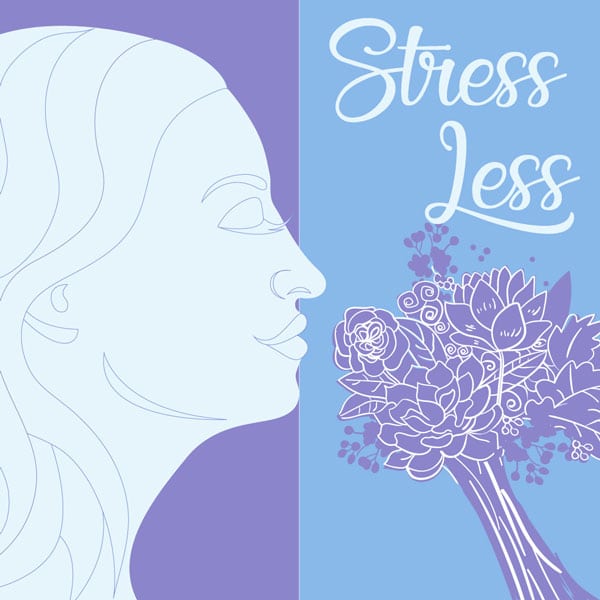University of North Florida Research Team Releases Findings on the Impact of Flowers on Well-Being
According to a survey by Wakefield Research, 68 percent of people feel stress on a weekly basis, and 32 percent are stressed every day. Women, in particular, are affected, as 1 in 4 report experiencing stress multiple times a day. With so many sources of stress today – from finances and health concerns, to our seemingly never-ending to-do lists – most people can relate to a constant state of frenzy.
Research from the University of North Florida shows that something as simple as flowers can help. The findings show that people who lived with flowers in their homes for just a few days reported a significant decrease in their levels of stress and improvements in their moods.
These new findings support other behavioral researchstudies conducted by researchers at universities including Harvard, Rutgers and Texas A&M that demonstrate flowers’ ability to make people happy, strengthen feelings of compassion, foster creativity and even provide a boost of energy.
The 2018 study, entitled, The Impact of Flowers on Perceived Stress Among Women, concludes that adding flowers to indoor environments results in a statistically significant and meaningful reduction in stress.
“There is a growing body of research that illustrates how environmental design positively impacts health. Now it is both intuitive and scientifically known that adding elements of nature, like flowers, to interiors promotes well-being,” said lead researcher Erin Largo-Wight, Ph.D., Associate Professor of University of North Florida’s Department of Public Health.
The specific results include:
- The average reduction in stress among the women who received and lived with flowers was -5.5 points on the Perceived Stress Questionnaire, a strong statistical significance in a decrease in stress.
- Flowers are a unique gift with the proven potential to reduce stress among women — likely because flowers provide the opportunity for nature contact, an established health-promoting environmental exposure.
- Participants who received flowers overwhelmingly reported that flowers improved their mood.
“Our findings are important from a public health perspective because adding flowers to reduce stress does not require tremendous effort to generate a meaningful effect,” said Largo-Wight. “When life seems to be in a constant state of frenzy, flowers can provide us with a much-needed moment of calm.”
Tips to Stress Less
Want to know how to relax and unwind? The Society of American Florists provides these easy tips on how to stress less:



- Experience flowers: Walk into your local flower shop and take a look around. Just the sight and smell of the natural beauty of flowers will put you at ease. Ask your florist to show you what’s in the cooler so you can learn about new varieties, colors and design styles.
- Color your world: Color therapists say colors really do affect our moods. The happiest color? Orange. It promotes optimism, enthusiasm, and a sense of uplift. Choose orange flowers — roses, gerberas, lilies, ranunculus, alstroemeria, tulips — to put on your kitchen counter or your desk, and see your mood soar.
- Find peace: If you are having a bad day when it seems like nothing is going right, try flowers in soothing, tranquil colors, such as blues, lavenders and pale greens. Place a small arrangement on your nightstand or in your bathroom, so you can experience the stress relieving benefits of flowers right before you go to bed, and right when you get up to start your day.
- Give yourself some joy: One great way to reconnect with joy and feel less stressed is to surround yourself with simple things that make you feel happy and loved, like a colorful bunch of flowers or a blooming plant. Flowers have the power to open hearts, and when your heart is open you are more likely to focus on the positive points in your day.
- Pepper your house with small doses of calm: When bringing home flowers from your florist, have a couple of small vases and containers available so you can place a few flowers in different parts of your living space. You’ll be amazed how many small arrangements you can get out of a single bunch of flowers, and you’ll have constant reminders to ‘stop and smell the flowers.’
- Be a friend: Do you have a friend or loved one who could use a boost? Have flowers delivered unexpectedly to their door, and watch their ordinary day become extraordinary. It will make you smile, too.
- Help others: Sometimes the best way to relieve stress and the pressures of the day, is to do something nice for someone else. Here’s an idea: Go to your florist and buy two bouquets. Keep one for yourself, then take the other bouquet and “petal it forward” to a stranger on the street. You’ll be amazed at the reaction to your random act of kindness.
UNF Study Methodology
A representative sample of 170 women between the ages of 18-65 were invited to participate in this experimental study. Participants were blinded to the purpose of the study and randomized into one of the following groups: flower home delivery (n=58), comparison gift home delivery (n=55, comparison group), and no delivery (n=57, control group). The no-delivery group served as the control and did not receive a delivery. The comparison group and flower group received a delivery on day five or six of the study. The flower group received an arrangement of flowers and the comparison group received a luxury candle of the same approximate value. Both items were prepared and delivered by a local florist and gift shop. All groups completed online stress surveys for 12 consecutive days. The instrument of focus here was the Perceived Stress Questionnaire (PSQ) that was administered at baseline (before delivery) and at post-test (after delivery).
Stress Survey:
Statistics on stress are from a survey of 1,004 nationally representative U.S. adults, ages 18+, by Wakefield Research in July 2018.

